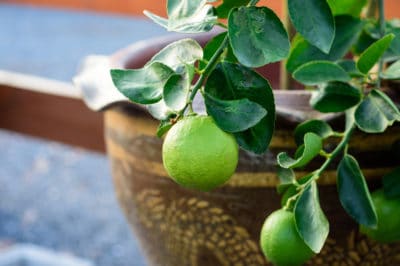The Tree
For a lime tree ideally suited to container life, choose the dwarf cultivar ‘Mexican Thornless’ (Citrus aurantifolia ‘Mexican Thornless’). It’s better known as a dwarf Key lime, but without those annoying thorns.
A 2- to 3-year-old tree is ready to flower and fruit. Kept in a container, it reaches reach 3 to 6 feet tall. Pruned occasionally, it remains smaller. Move it outside during your warmest months and return it indoors before nighttime temperatures fall below 50°F (10°C).
The Container
Grow you lime in a porous terra cotta container with several drainage holes. Start with one slightly bigger than the rootball, set in a drainage saucer filled with stones. They’ll raise the base of the pot so air reaches the roots and discourages root rot.
Expert gardener’s tip: Move the tree to a larger pot only when it becomes rootbound and stops getting taller.
The Potting Medium
Plant in a well-draining potting medium formulated for citrus trees. Look for one that’s slightly acidic, with a pH between 6.0 and 7.0.
Sunlight
Provide your lime with eight to 12 hours of daily sun. A south-facing window works. In winter, supplement the natural light with a grow light if necessary.
Watering
When the growing medium’s surface feels dry but the root ball is still slightly moist, it’s time to water. Track the moisture level with a moisture meter from your garden store. Water deeply and — to discourage root rot — empty the drainage saucer immediately afterwards.
Curled leaves mean a thirsty lime tree; cupped or yellowing leaves could mean an overwatered one.
Fertilizer
Your lime needs a wide range of nutrients. Supply them with:
- A granular, slow-release organic fertilizer containing nitrogen, phosphorous and potassium (N-P-K) in a 2-1-1 ratio.
- A trace mineral supplement with calcium, zinc, iron and manganese.
- Potassium silicate liquid.
Apply them all at their labels’ recommended amounts and frequencies for container plants.
Temperature and Humidity
Lime trees growing indoors are happiest between 55°F and 85°F (12.8°and 29.4°C). That said, unless the daytime temp is 5° to 10°F (2.5°to 5.4°C) higher than the nighttime one, they don’t flower.
The trees also thrive with humidity of 50 percent or more. During winter, place a humidifier near the pot to compensate for dry indoor air. Or, move the tree to a sink or shower and mist the leaves with a spray bottle once a week.
